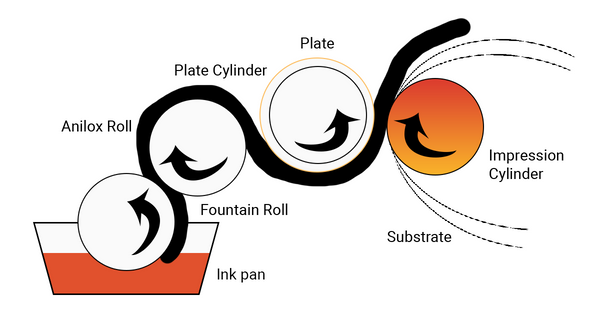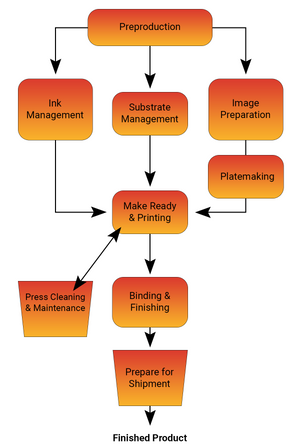Process Overview
IN THE TYPICAL FLEXOGRAPHY PRINTING SEQUENCE, THE SUBSTRATE IS FED INTO THE PRESS FROM A ROLL.
The image is printed as the substrate is pulled through a series of stations or print units. Each one prints a single color. As with Gravure and Lithographic printing, the various tones and shading are achieved by overlaying the four basic shades of ink:
CYAN | MAGENTA | YELLOW | BLACK

THIS IS A DIAGRAM AND FURTHER DESCRIPTION DEMONSTRATING THE FLEXOGRAPHY PRINTING SEQUENCE:
The process of printing each color on a flexo press consists of a series of four rollers:
- Ink Roller
- Meter Roller
- Plate Cylinder
- Impression Cylinder
The first roller transfers the ink from an ink pan to the meter roller, or Anilox Roll. The Anilox roller then meters the ink to a uniform thickness onto the plate cylinder to avoid bubbling or spots on the label. The substrate then moves between the plate cylinder and to the fourth roller, the impression cylinder.
The impression cylinder applies pressure to the plate cylinder, thereby transferring the image onto the substrate. The web, which by now has been printed, is fed into the overhead dryer so the ink is dry before it goes to the next print unit.
After the substrate has been printed with all colors, the web may be fed through an additional overhead tunnel dryer to remove most of the residual solvents or water. The finished product is then rewound onto a roll or is fed through the cutter.
To learn more or to start your label printing services, contact us at Impression Label today!

Here is a breakdown of our typical process from start to finish:
Learn More About Flexography Printing
Are you interested in learning more about the flexography printing process? Impression Label is here to help. Our printing company has been providing customers with quality label printing services for more than three decades. We have the experience and expertise to provide you with the printing services you need. Contact us today to learn more and place an order.
